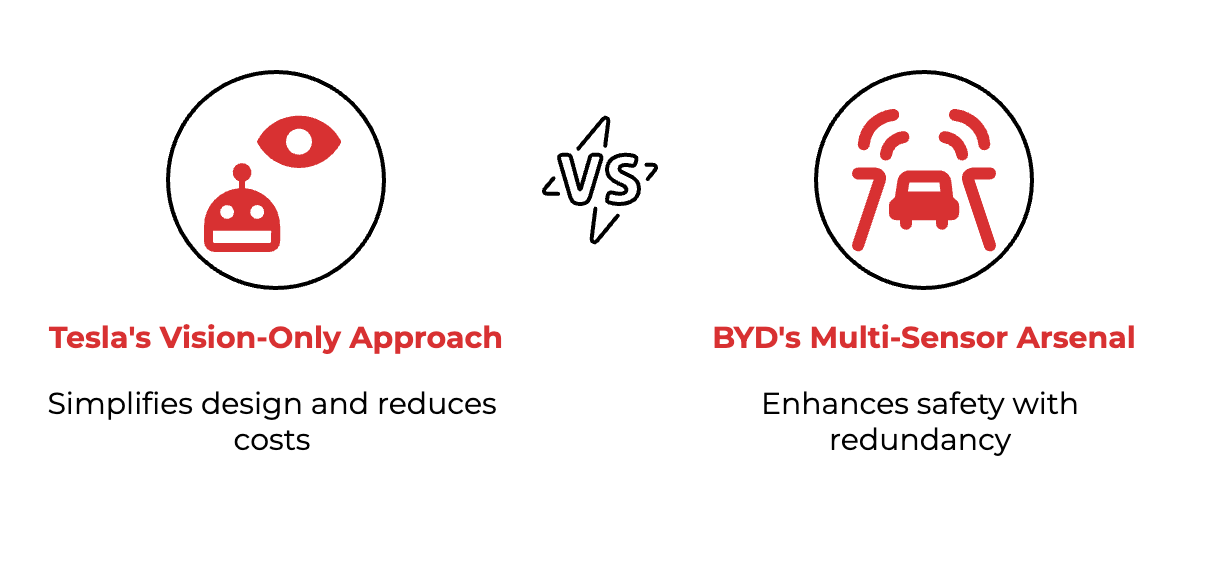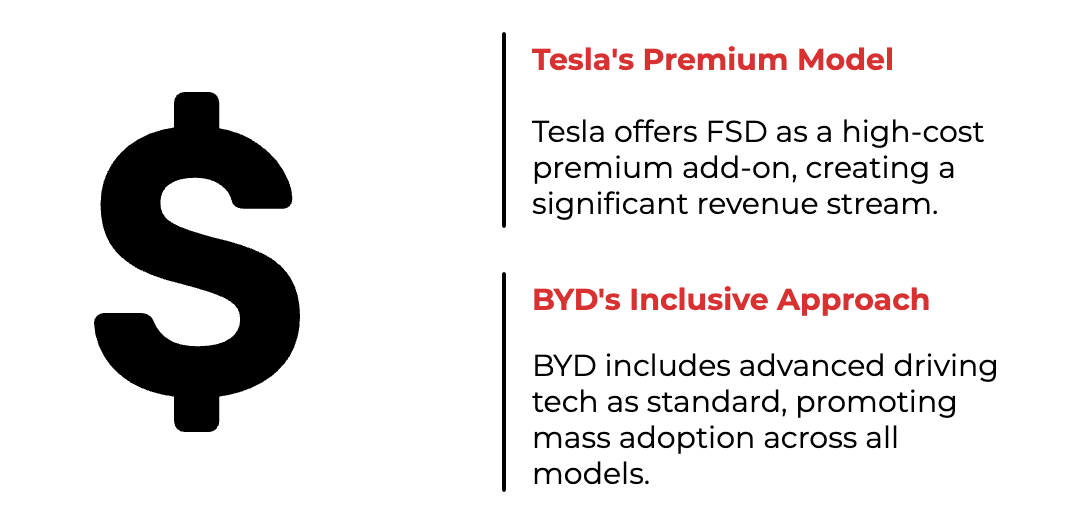How BYD and Tesla Are Taking Different Paths to Autonomous Driving
East-West AI Battle Reshapes How We Drive
Hey Adopter,
Self-driving tech is following two very different paths right now, and the contrast couldn't be more striking. In February, BYD started giving away its God's Eye system on every car they make – from $9,500 hatchbacks to $233,500 supercars. Meanwhile, Tesla charges $99 monthly or $8,000 upfront for their Full Self-Driving tech. But the differences go way beyond price tags and marketing strategies.
These companies represent two fundamentally different philosophies about how AI should work in cars, and their approaches reveal a deeper divide in how East and West think about technology adoption. Let's dive into what this means for the future of driving and AI implementation.
How They See the World: Vision vs Redundancy
Tesla and BYD couldn't be more at odds about how a car should perceive the world. Tesla keeps it deliberately simple with a camera-based system. They've actually removed radar from newer models, and Elon Musk famously called LiDAR "stupid, expensive, and unnecessary." Their bet? That powerful AI can interpret visual data like humans do – we don't need lasers in our eyes to drive, so why should cars?
BYD takes the opposite approach, essentially throwing every available sensor at the problem. Their entry-level God's Eye C packs 12 cameras, 5 radars, and 12 ultrasonic sensors. Move up to God's Eye B, and they add a LiDAR sensor. Their premium God's Eye A comes with a triple LiDAR setup that would make a self-driving engineer drool.
Tesla's approach makes for cleaner, less expensive hardware with fewer potential points of failure. BYD's multi-sensor strategy gives their cars redundant ways to "see" the world – if cameras get blinded by sun glare, the radar and LiDAR keep working. Neither approach is inherently superior; they reflect fundamentally different beliefs about solving the same complex problem.
Building the Brains: Vertical Integration vs Collaborative Intelligence
The companies diverge just as dramatically in how they develop their AI systems. Tesla builds everything in-house – they design their own AI chips, build their neural networks from scratch, and control every line of code in the system. This gives them incredible control and the ability to update the entire technology stack with a single over-the-air update. It's an Apple-like approach of owning the entire ecosystem.
BYD instead partners with AI specialists, working with DeepSeek to integrate their large language model into their cars. They're tapping into China's broader AI ecosystem rather than trying to build everything themselves. They're combining automotive expertise with specialized AI knowledge in a more Android-like model of integration.
This isn't just about development strategy – it reflects profoundly different views on innovation. Tesla believes the best products come from controlling every aspect of development. BYD believes that specialized expertise from multiple partners creates better overall results. Both views have merit, and both come with tradeoffs.
Real-World Performance: The Rubber Meets the Road
What matters most is how these systems actually perform on real roads with real drivers. Tesla's FSD reduces fatigue on long trips and handles lane changes and highway exits competently. It stops reliably for traffic signals and improves steadily through software updates. But it also has occasional issues with lane drift, struggles in construction zones, and experiences "phantom braking" in some situations. And despite the name, it still requires constant driver attention as a Level 2 autonomy system.
BYD claims their God's Eye C can go 1,000 km between human interventions and offers precise parking capabilities. Their higher-tier versions reportedly reach Level 3 autonomy in some conditions, potentially offering better performance in challenging situations like fog or night driving thanks to that sensor redundancy. But there's less public data on real-world performance, and the more complex sensor suite could mean more potential maintenance issues down the road.
Both companies continuously improve their systems, but the real difference is in their starting assumptions. Tesla believes simplicity and powerful AI will win the day. BYD hedges their bets with multiple sensor types working in concert. Time will tell which approach delivers better real-world results.
Pricing Philosophy: Premium Service vs Core Feature
The pricing strategies reveal deeper thinking about AI's place in our products. Tesla treats FSD as a premium add-on worth paying extra for – either $8,000 upfront or $99 monthly. This creates an additional revenue stream that helps fund continued development. It's a model that says AI-driven features are value-added services that command a premium.
BYD's free inclusion across their lineup takes the opposite view – that advanced driving tech should be standard equipment, not an optional extra. They're using technology as a competitive differentiator and accelerating mass adoption across all price points. Their model treats AI as a core feature that everyone should have access to, not a luxury for those who can afford it.
These approaches typify different perspectives on technology adoption. Is advanced AI a premium service that commands its own price tag? Or is it becoming table stakes – expected in every product regardless of price point? The market will ultimately decide, but BYD's move throws down a serious gauntlet.
The Regulatory Landscape: National Strategy vs Patchwork Rules
Both companies navigate very different regulatory environments that shape their rollout strategies. China takes a more coordinated national approach to autonomous tech, with extensive test roads available (around 20,000 miles) and government support for autonomous development. This creates a more predictable environment for companies like BYD.
The United States operates with state-by-state regulations that create inconsistency and uncertainty. Some states welcome autonomous testing with open arms, while others impose significant restrictions. Tesla faces different hurdles in every state, while also dealing with national security concerns that might restrict Chinese autonomous vehicles in American markets.
These regulatory differences will determine how quickly and broadly each approach can spread globally. A technology is only as good as its ability to navigate the legal frameworks where it operates.
Beyond Autonomous Driving
This technological battle isn't just about who builds a better self-driving car. It's about competing visions for how AI enters our lives and transforms industries. Tesla builds everything themselves, maintains tight control, charges a premium, and continuously improves. BYD integrates multiple systems, collaborates broadly, makes technology accessible to everyone, and treats AI as a standard feature rather than an add-on.
We're seeing these same patterns repeat across industries. Should AI be a premium offering or a standard feature? Built in-house or integrated from specialists? Simple but focused, or complex but redundant? Monetized directly or used as a competitive edge? The companies that figure out the right balance for their specific industry will lead the next wave of AI adoption.
Both approaches have genuine merit, and both face real challenges. The next few years will reveal which path leads to broader adoption and better real-world performance. For now, it's a fascinating case study in how different philosophical approaches can lead to completely different implementations of the same technology.
Adapt & Create,
Kamil








Thanks. Really learned a lot about the difference between both approaches.